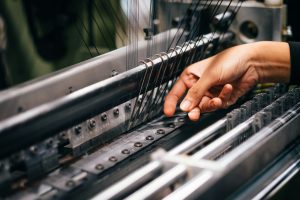Key Takeaways:
- The history of textiles spans over 30,000 years, evolving from natural fibers to advanced synthetic materials.
- The Industrial Revolution introduced mechanization, significantly increasing textile accessibility and production efficiency.
- Natural fibers such as cotton and wool offer comfort and biodegradability, while synthetic fibers like polyester and nylon dominate the market for their durability and versatility.
- Innovations in fabric construction methods, including weaving, knitting, and non-woven techniques, enhance performance and reduce waste.
- Smart textiles integrate technology for health monitoring, temperature regulation, and user interaction, representing a fusion of fashion and functionality.
- Responsive materials can adapt to environmental stimuli, offering enhanced user experience in textile applications.
- Eco-friendly innovations, including organic and recycled materials, are becoming essential in the textile industry to address sustainability challenges.
- Supply chains are transforming with a focus on sustainability, reducing waste, and implementing circular fashion practices.
- Biodegradable materials offer a greener alternative to traditional synthetics, promoting a more sustainable lifecycle for garments.
- 3D printing technology revolutionizes textile production by allowing customization and reducing waste associated with traditional methods.
- Medical textiles enhance patient care with smart bandages and biocompatible materials for improved healing and monitoring.
- Textiles in automotive and aviation sectors improve safety, performance, and passenger comfort through advanced materials.
- The integration of smart textiles in home automation enhances functionality and comfort in living environments.
The Evolution of Textile Technology: From Fibers to Fabrics
A Brief History of Textiles: Milestones and Innovations
The story of textiles is as old as civilization itself, tracing back over 30,000 years to the earliest known examples of textile use. Archaeological findings indicate that the first textiles were made from natural fibers, such as flax and cotton, which were hand-spun into thread and woven into fabrics. In ancient Egypt, linen was not only a staple for clothing but was also used in the mummification process, highlighting the cultural significance of textiles. The invention of the spinning wheel around 1000 AD and the loom further accelerated textile innovations, allowing for increased production and intricate designs.
The Industrial Revolution marked a watershed moment in textile history, unlocking a new era defined by mechanization and mass production. The introduction of machines such as the cotton gin, which streamlined the separation of cotton fibers from seeds, and the power loom transformed the landscape, making textiles more accessible to the common people. With evolving technologies, synthetic fibers emerged in the early 20th century. Nylon, introduced in 1935, was the first synthetic fiber and drastically changed how textiles were produced. Polyester, invented in the 1940s, further pushed the boundaries of what fabrics could be. It was stronger, more durable, and resistant to wrinkling than its natural counterparts, setting the stage for modern innovations that continue to evolve.
The Journey of Natural and Synthetic Fibers
The distinction between natural and synthetic fibers is fundamental to understanding contemporary textile technology. Natural fibers—like cotton, wool, silk, and linen—have been revered for their comfort, breathability, and biodegradability. Each has its unique properties that cater to different requirements, making them staples in both fashion and functional textiles. Cotton, for instance, is loved for its softness and moisture-wicking abilities, while wool is prized for its warmth and inherent moisture control, making it ideal for outdoor apparel.
In contrast, synthetic fibers, derived from petrochemicals, have increasingly influenced the textile industry due to their versatility and utility. Materials such as polyester, nylon, and spandex dominate the market, offering properties such as stretchability, durability, and resistance to moisture. The rise of these non-biodegradable fibers has raised environmental concerns, spurring innovations in recycling technology and the development of biodegradable synthetics, like polylactic acid (PLA), derived from cornstarch. As consumers increasingly seek sustainable options, there is a vibrant push towards bio-based and recycled textiles, representing a shift towards more responsible fiber selection.
Advancements in Fabric Construction Techniques
Technological advancements in fabric construction have transformed the textile landscape, giving rise to innovative methods that enhance performance and functionality. Techniques such as weaving, knitting, and bonding have adapted to incorporate high-tech developments. For instance, jacquard weaving, which allows for intricate patterns and designs, has evolved with the use of computer-assisted technologies, enabling designers to create complex textures that were once impossible. Additionally, advancements in knitting technology have led to seamless garments that enhance comfort and reduce waste.
Another significant method revolutionizing fabric construction is the introduction of non-woven fabrics, produced by bonding fibers together through heat, chemicals, or adhesives. Non-woven fabrics offer unique characteristics such as durability, filtration, and absorbency, making them ideal for applications ranging from medical supplies to automotive interiors. The increased speed of production and adaptability of these methods align closely with the industry’s growing need for quick turnaround times and customized solutions for diverse applications.
Smart Textiles: The Intersection of Fashion and Technology
Wearable Tech: Enhancing Daily Life with Intelligent Fabrics
Wearable technology has become one of the most exciting intersections of fashion and technology, with smart textiles paving the way for innovative applications in everyday life. These fabrics incorporate electronic components, sensors, and conductive threads that enable garments to interact with the user and their environment. For example, workout clothing integrated with heart rate monitors can track biometric data, providing immediate insights into an individual’s physical condition and performance.
Moreover, innovations such as temperature-regulating fabrics that respond to body heat and moisture levels offer unprecedented comfort. Companies like Under Armour have developed clothing that can wick sweat away from the body and regulate temperature through embedded technology. The potential for health monitoring through fabric technology could revolutionize personal healthcare, providing real-time data on vital signs and even potential medical issues, thus empowering consumers like never before.
Responsive Materials: How Textiles Can Adapt to Your Needs
Responsive materials, or adaptive textiles, represent a significant leap forward in textile technology, enabling fabrics to change properties based on environmental stimuli. These materials can respond to factors such as temperature, light, and moisture, enhancing user experience and functionality. For instance, textiles embedded with phase change materials (PCMs) can absorb and release heat, aiding in temperature regulation for the wearer in varying conditions, making them ideal for outdoor gear.
Furthermore, color-changing fabrics that utilize thermochromic or photochromic technologies revolutionize the way clothing can interact with the environment. Such textiles can shift colors in response to temperature or UV light exposure, providing both aesthetic appeal and functional benefits. This innovation not only adds a dynamic element to fashion but also serves practical purposes, such as improving safety for outdoor workers who need to be visible in various lighting conditions.
Eco-friendly Innovations: Merging Style with Sustainability
As the fashion industry grapples with sustainability challenges, eco-friendly innovations are becoming increasingly popular, merging style with environmental consciousness. Designers and manufacturers are exploring alternative materials such as organic cotton, hemp, and recycled polyester, which reduce the carbon footprint associated with textile production. Innovations in dyeing processes that use less water and fewer harmful chemicals are also making significant impacts, resulting in less pollution and waste.
Additionally, numerous brands are exploring closed-loop systems to create circular fashion, where old garments are recycled and transformed into new products, essentially minimizing textile waste. For example, Adidas’ collaboration with Parley for the Oceans utilizes recycled ocean plastic to create sportswear, highlighting how brands can innovate sustainably while also promoting environmental awareness. As sustainability becomes an integral part of textile innovation, consumers are increasingly drawn to companies committed to ethical practices, shaping the future of the industry.
The Future of Textile Production: Sustainability Meets Innovation
Revolutionizing Supply Chains: From Waste Reduction to Circular Fashion
The textile industry’s supply chain is undergoing profound changes as companies embrace new technologies and business models designed for sustainability. In response to global demand for more responsible manufacturing practices, the focus on reducing waste and implementing circular fashion is becoming paramount. This transformation requires redefining how textiles are produced, distributed, and consumed. Automation technologies are optimizing manufacturing processes, effectively minimizing waste and energy consumption, while platforms that encourage reselling and recycling garments are changing consumer behavior.
Innovative approaches like blockchain technology are also enhancing transparency in the supply chain, enabling consumers to trace the origins of their clothing and ensuring brands meet ethical standards. By prioritizing sustainable sourcing, manufacturers are not only complying with regulations but also appealing to a growing market of environmentally conscious buyers. This drive towards circular fashion indicates a substantial shift in the industry, leading to more sustainable consumption patterns and pushing for frameworks that facilitate comprehensive recycling initiatives.
Biodegradable Materials: A Greener Approach to Fashion
The emergence of biodegradable materials represents a revolutionary stride towards sustainability in the textile industry. Traditional synthetic fibers can take hundreds of years to decompose, contributing to the global textile waste crisis. In contrast, biodegradable textiles, created from natural polymers or innovative bio-based materials, promise to break down quickly and harmlessly in the environment. Fibers like Tencel, made from sustainably sourced wood pulp, and biodegradable polyester developed from renewable resources are gaining traction as environmentally friendly alternatives.
This trend is particularly significant for fast fashion brands, pushing them to reconsider material choices and production methods. The integration of biodegradable materials into mainstream fashion encourages a more sustainable lifecycle for garments—from production to disposal—thus addressing the pressing issue of landfill overflow. As consumer awareness of environmental issues increases, the demand for biodegradable options will continue to rise, compelling brands to innovate and adapt accordingly.
3D Printing in Textiles: Crafting the Future of Fabric
The advent of 3D printing technology is revolutionizing textile production, allowing for unprecedented customization and efficiency in creating garments. This technology enables designers to prototype and produce items with intricate designs directly from digital models, drastically reducing material waste associated with traditional cutting methods. Automotive and fashion industries are experimenting with 3D-printed textiles that offer unique capabilities, such as flexibility and customized fit, which were previously unattainable.
Moreover, the ability to produce garments on-demand through 3D printing contributes to sustainability by minimizing overproduction. Brands can create limited-edition pieces that align closely with consumer demand, reducing unsold inventory and waste. The future implications of weaving advancements into 3D printing incorporate less waste, lower costs, and enhanced design complexity, opening new horizons for both fashion and function in textiles.
Textile Technology in Diverse Fields: Beyond Fashion
Medical Textiles: Innovations for Health and Healing
The application of textile technology in the medical field has introduced groundbreaking innovations that improve patient care and enhance healing. Medical textiles encompass a range of products, including wound dressings, surgical gowns, and smart bandages equipped with sensors that monitor vital signs or detect infections. These advanced materials serve multiple functions, such as providing moisture control, antibacterial properties, and improved comfort for patients.
Innovations such as biocompatible materials are crucial in surgical applications, as they minimize the risk of rejection and promote healing. Textiles incorporated in medical devices can deliver medication over time or provide real-time feedback through integrated sensors. Prominent research in smart textiles reveals capabilities like temperature regulation in burn dressings or monitoring glucose levels in diabetic patients through wearable sensors, marking a promising future for integrating textiles with healthcare technology.
Automotive and Aviation Textiles: The Role of Fabrics in Safety and Performance
Textiles play a critical role in the automotive and aviation industries, significantly impacting safety, performance, and passenger comfort. In automobiles, fabrics are vital to interior design, contributing to aesthetics but also to the overall functionality of the vehicle. Advanced textile materials designed for resilience, fire resistance, and easy maintenance are highly sought after, improving sustainability and safety within automotive upholstery.
Additionally, aviation textiles have evolved to meet stringent standards while promoting passenger comfort. Lightweight, durable fabrics enhance fuel efficiency and performance while ensuring safety. Innovations in noise-dampening textiles improve passenger experiences, while breathable fabrics maintain comfort on long flights. As regulations around safety strengthen, the integration of high-performance textiles in these industries ensures advancements not only enhance user experience but also optimize safety measures.
Smart Homes: The Role of Textiles in Home Automation
The rise of smart home technology has opened new avenues for the integration of textiles into our living environments. Smart textiles embedded with electronics allow for enhanced functionality in home decor, merging aesthetics with utility. For example, curtains with light-sensing technology can automatically adjust based on sunlight, helping regulate indoor temperature and privacy while reducing energy costs.
Innovations such as sound-absorbing fabrics are being integrated into interior design, promoting better acoustics in spaces where noise reduction is necessary. Textiles that incorporate heating elements or temperature-regulating features are revolutionizing comfort in home settings—allowing users to customize their environments more easily. The ongoing evolution of IoT (Internet of Things) is set to enhance the capabilities of smart textiles in the home, ensuring that technological advancements continue to harmonize with our everyday lives.
In summary, as we venture deeper into the realm of textile technology, we witness an evolution characterized by sustainability, innovation, and functionality that transcends the industry’s traditional boundaries. The developments in textile technology signal a future where our clothing and surroundings adapt to our needs, drive environmental stewardship, and redefine what is possible in textiles.








